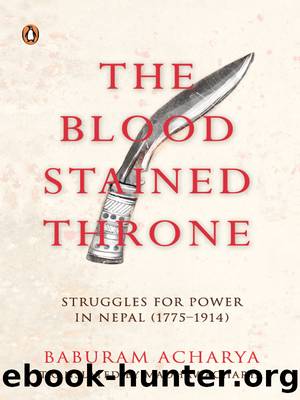The Bloodstained Throne by Baburam Acharya

Author:Baburam Acharya [Acharya, Baburam]
Language: eng
Format: epub
ISBN: 9789351182047
Publisher: Penguin Books Ltd
Published: 2013-03-04T00:00:00+00:00
SIX
The Kot Massacre and the Dawn of the Rana Rule
Unpublished, written in 1961 under the title âEstablishment of Rana Rule through Violent Revolutionâ
Following the demise of General Mathbarsingh Thapa, the Nepalese royal family faced the crucial question of who would take control of the countryâs administration. While King Rajendra wanted to keep it to himself, Queen Rajyalaxmi had hatched the conspiracy against Mathbar driven by her desire to wrest the all-important authority. From a legal standpoint, both the king and the queen had bequeathed the authority to Crown Prince Surendra when he was invested with the title of Baby-King. It was indeed a complicated issue, since neither of them was prepared to see their powers rescinded.
Also confused was the nobility, which however quickly worked out a formula. A âpeace planâ aimed at maintaining peace and harmony among the king, the queen and the crown prince was made. Accordingly, on matters of state administration, the king would direct orders to the crown prince, who would then pass them on to the queen, while the queen would in turn relay them to the courtiers. When the courtiers placed this modus operandi before the trio, all the claimants to the authority agreed. Thus, acquiring the documents and papers duly stamped by both the father and the son, Queen Rajyalaxmi again assumed control of the state administration, on 26 May 1845.
Even though the queen had taken full control of the administration, the king, being the source of all orders and directives, had not lost his say in matters. Yet, since the queen had the right to the red seal, no important decisions that would go against her wishes could be taken. But because all directives originated from the monarch, there was a kind of joint control over the administration. In this division of power, practically speaking, the crown prince turned out to be the loser since his authority was now wedged between that of the king and the queen.
When the new Courtiersâ Council was being formed, the queen expressed her desire to appoint Gagansingh Bhandari, loyal to her son Ranendrabikram Shah, as prime minister. King Rajendraâs choice for the position was Fattejung Shah. In the end, the king prevailed, and Gagansingh had to settle for the position of acting prime minister and commander-in-chief only for the yearâs rainy season. During this time, Ranganath Pandit and brother Krishna Pandit were living in exile in India, just like Fattejung Shah and Abhimansingh Rana. Now the Pandit brothersâ allocations were restored and released though they had not yet returned to Kathmandu. Fattejung and Abhimansingh returned to the capital in September, thereby speeding up the formation of the new council of ministers.
In the new Cabinet, Fattejung Shah was appointed the prime minister, courtesy the king. He was also given the charge of three regiments as well as the passes and routes of west Nepal. The foreign affairs portfolio also belonged to him. Fattejung got back the property that had been confiscated by Mathbarsingh Thapa. Abhimansingh Rana was inducted
Download
This site does not store any files on its server. We only index and link to content provided by other sites. Please contact the content providers to delete copyright contents if any and email us, we'll remove relevant links or contents immediately.
| Diaries & Journals | Essays |
| Letters | Speeches |
The Rules Do Not Apply by Ariel Levy(4842)
Bluets by Maggie Nelson(4472)
Too Much and Not the Mood by Durga Chew-Bose(4270)
Pre-Suasion: A Revolutionary Way to Influence and Persuade by Robert Cialdini(4144)
The Motorcycle Diaries by Ernesto Che Guevara(4009)
Walking by Henry David Thoreau(3892)
Schaum's Quick Guide to Writing Great Short Stories by Margaret Lucke(3317)
What If This Were Enough? by Heather Havrilesky(3270)
The Daily Stoic by Holiday Ryan & Hanselman Stephen(3230)
The Day I Stopped Drinking Milk by Sudha Murty(3159)
The Social Psychology of Inequality by Unknown(2936)
Why I Write by George Orwell(2874)
Letters From a Stoic by Seneca(2733)
A Short History of Nearly Everything by Bryson Bill(2627)
A Burst of Light by Audre Lorde(2546)
Insomniac City by Bill Hayes(2494)
Feel Free by Zadie Smith(2433)
Upstream by Mary Oliver(2339)
Miami by Joan Didion(2322)
